Effortless Mediterranean Pasta Salad: Your Ultimate Summer Side Dish & Picnic Essential
Discover the ultimate **Mediterranean pasta salad** recipe, a vibrant celebration of colors and fresh flavors perfect for all your summer gatherings, from lively barbecues to serene picnics. This easy-to-make dish combines sweet grape tomatoes, crisp cucumbers, savory Greek Kalamata olives, tender artichoke hearts, and creamy, tangy feta cheese. Each element is brought together with a bright, zesty lemon-herb vinaigrette crafted with fresh herbs, making it an irresistible addition to any meal. Whether you need a gluten-free pasta salad, a dairy-free option, or simply a delicious make-ahead dish that travels beautifully, this recipe has you covered. It’s truly a summer entertaining hero, promising a refreshing and satisfying culinary experience.
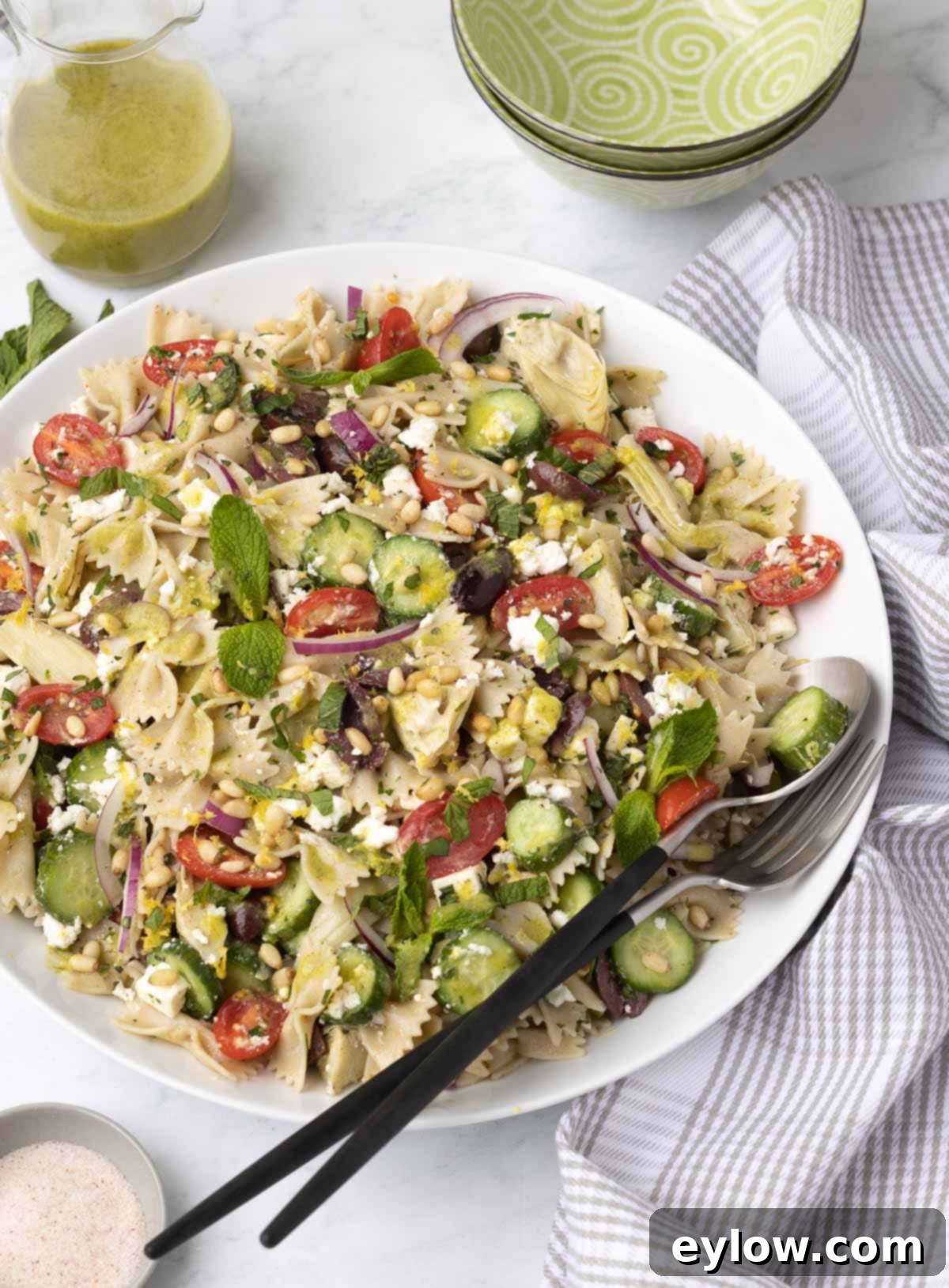
Who can resist a truly fantastic summer pasta salad? This particular Mediterranean pasta salad stands out, drawing much of its inspiration and many beloved elements from a classic Greek salad. It’s designed to be a crowd-pleaser, offering a symphony of textures and tastes that perfectly capture the essence of warm weather dining. Prepare to fall in love with its refreshing simplicity and robust flavor profile.
[feast_advanced_jump_to]
Why This Easy Mediterranean Pasta Salad Will Be Your New Favorite
There are countless reasons why this Mediterranean pasta salad recipe is destined to become a staple in your kitchen, especially during the warmer months. Its convenience, adaptability, and incredible flavor make it a standout dish:
- Bursting with Mediterranean Flavors and Vibrant Colors: Every bite is an explosion of fresh ingredients. The combination of ripe tomatoes, green cucumbers, purple olives, and white feta against the backdrop of pasta and fresh herbs creates a visual feast as appealing as its taste. It’s a truly healthy pasta salad packed with wholesome goodness.
- Perfect for Any Summer Gathering: This versatile dish is ideal for a wide range of occasions. From casual backyard barbecues and lively summer cookouts to elegant al fresco dining and relaxed family picnics, it consistently delivers. Its robust structure ensures it holds up well, making it a reliable choice for potlucks and outdoor events.
- Effortless Make-Ahead Convenience: Save yourself time and stress by preparing this pasta salad in advance. The flavors actually deepen and meld beautifully overnight, enhancing the overall taste experience. Simply dress it just before serving to maintain optimal freshness and texture, making it a perfect make-ahead pasta salad.
- Incredibly Refreshing on Hot Days: Served chilled, this pasta salad offers a delightful coolness that is incredibly welcome during scorching summer temperatures. The zesty lemon vinaigrette and crisp vegetables provide a refreshing contrast, making it a light yet satisfying meal or side.
For another fantastic summer option, be sure to try this equally delicious cold lentil and quinoa salad, offering a different take on Mediterranean-inspired freshness.
Essential Mediterranean Pasta Salad Ingredients
Crafting the perfect Mediterranean pasta salad starts with selecting high-quality, fresh ingredients. Each component plays a vital role in achieving the signature vibrant flavors and satisfying textures of this delightful dish.
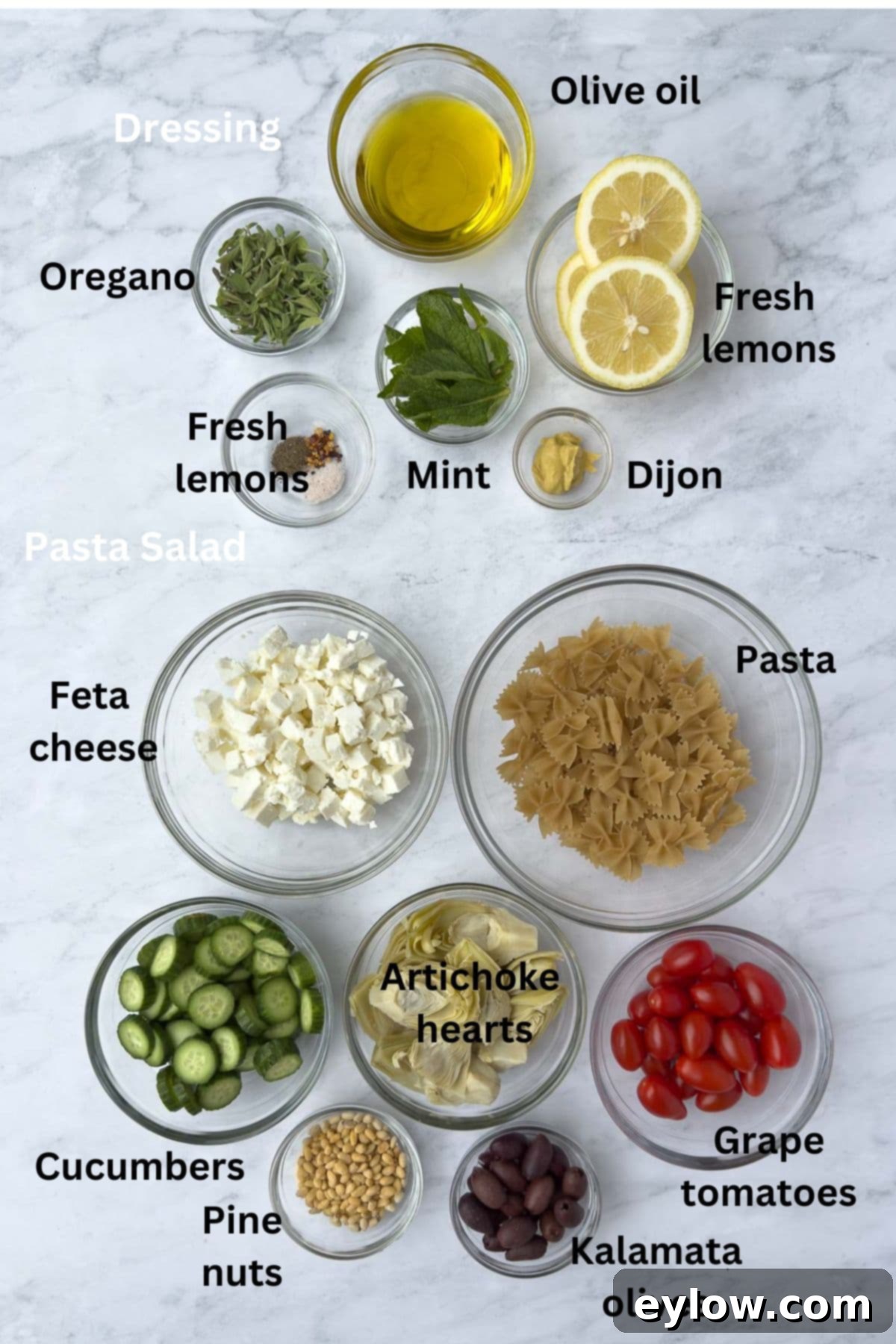
For the Pasta Salad Base:
- Pasta: The foundation of any great pasta salad! You can choose between gluten-free or traditional wheat pasta, depending on your dietary needs. For optimal texture and easy eating, opt for a short pasta shape. Excellent choices include elbows, bows (farfalle), mini penne, rotini, or corkscrew (fusilli). These shapes effectively capture the dressing and mingle well with the other ingredients. Here’s my favorite gluten-free pasta that holds its shape beautifully.
- Cucumber: Adds a delightful crunch and fresh coolness. While any cucumber works, I particularly love the sweet, crisp bite of small Persian cucumbers. English cucumbers are also a great choice, offering minimal seeds. If using larger field cucumbers, remember to peel and potentially seed them for the best texture and to prevent a watery salad.
- Tomatoes: Introduce a burst of sweet acidity and vibrant color. Sweet grape tomatoes or juicy cherry tomatoes are ideal, halved for bite-sized pieces. For a deeper, more concentrated flavor, consider adding some chopped sun-dried tomatoes (oil-packed and drained) for an extra layer of Mediterranean richness.
- Cheese: Tangy Greek feta cheese is practically a requirement for a truly authentic Mediterranean experience. Its salty, briny flavor and crumbly texture perfectly complement the other ingredients. Goat cheese can be a delicious alternative if you prefer a slightly different tang. If you’re aiming for a dairy-free pasta salad, simply omit the cheese or use a high-quality dairy-free feta substitute, crumbled or cubed.
- Olives: Briny, meaty olives are essential. Pitted Kalamata olives are my top recommendation for their rich, distinctive flavor. Green olives can also be used if preferred. Halve them if they are large to ensure an even distribution throughout the salad.
- Artichoke Hearts: These add a wonderful earthy flavor and tender texture. Look for canned artichoke hearts packed in water, which are easy to prepare. Ensure they are thoroughly drained and chopped if the pieces are too large.
- Onion: A touch of finely chopped red onion provides a sharp, savory bite and beautiful color. If you find red onion too potent, a milder shallot can be used instead. A chef’s tip to tame the raw bite of red onion: chop it, rinse it briefly under cold water, and then pat it completely dry before adding it to the salad. This significantly mellows its intensity.
- Herbs: Fresh herbs are key to brightening the flavor profile. Generous amounts of chopped fresh parsley contribute a lovely garden-fresh taste and additional green flecks of color.
- Nuts: Buttery pine nuts toasted lightly add a fantastic crunch and a subtle, rich flavor. They are optional but highly recommended for an extra layer of texture. If you have nut allergies, simply omit them.
If you enjoy the sweetness of grape and cherry tomatoes, you might also love this elegant cherry tomato tart or these flavorful roasted grape tomatoes. And for a different classic take on pasta salad, check out this Best Ever Macaroni Salad from my friend Laura.
Chef’s Tip: For effortlessly clean and easy slicing of fresh tomatoes, invest in a small serrated knife, often called a tomato knife. Its sharp, serrated edge glides through delicate skins without crushing the pulp, making prep work a breeze. It’s also surprisingly versatile for other soft fruits and vegetables!
Crafting the Zesty Lemon-Herb Vinaigrette Dressing
A homemade dressing truly elevates this Mediterranean pasta salad (and frankly, any salad!). This lemon-herb vinaigrette is bright, fresh, and perfectly balances the rich flavors of the other ingredients.
- Olive Oil: The cornerstone of any good vinaigrette. Use a high-quality extra virgin olive oil for its rich, fruity notes. For an extra citrusy punch, a lemon-infused olive oil can be a delightful choice.
- Lemon Juice: Only freshly squeezed lemon juice will deliver the vibrant, tangy, and bright flavor that makes this dressing sing. Before juicing, remember to zest the lemon; this aromatic zest can be added to the dressing or reserved for garnish, providing an intense burst of lemon essence.
- Fresh Herbs: A fragrant blend of fresh mint and thyme (or oregano) forms the aromatic heart of this vinaigrette. Mint adds a cooling freshness, while thyme or oregano contributes a classic Mediterranean depth. Chopped chives can also be used for garnish, offering a mild oniony note.
- Dijon Mustard: Just a small amount of smooth Dijon mustard is added not only for its distinct, slightly spicy Mediterranean flavor but also for its crucial role as an emulsifier. It helps to bind the oil and lemon juice together, creating a creamy, stable dressing.
- Seasonings: Simple yet essential. Fine sea salt and freshly ground black pepper enhance all the other flavors. For a subtle kick, a pinch of red chili flakes is an optional but highly recommended addition.
- Honey: This is an optional ingredient, used to balance the flavors. If you find the vinaigrette too tangy or sharp, a small amount of honey can be added to soften the acidity and round out the taste profile without making it sweet.
To further amplify the freshness, use extra chopped mint and oregano to mix into the salad just before serving. Don’t forget to sprinkle with the reserved lemon zest from when you juiced the lemons – it adds both visual appeal and an extra layer of bright, aromatic lemon flavor.
Please refer to the detailed recipe card below for precise measurements of all ingredients, including salt and pepper, to ensure perfect balance.
Chef’s Tip: Fresh basil leaves are an absolutely wonderful addition to this Mediterranean pasta salad, offering a sweet, peppery aroma. To prepare them like a pro, select large, vibrant basil leaves from a bunch. Stack several leaves neatly on top of each other, then gently roll them lengthwise into a tight cigar shape. Using a very sharp knife, thinly slice crosswise into delicate ribbons. This technique is called “chiffonade.” Add these beautiful basil ribbons just before serving to preserve their vivid green color and delicate flavor, preventing them from wilting or bruising in the salad.
Creative Substitutions and Exciting Variations
One of the best aspects of this Mediterranean pasta salad is its incredible flexibility. Feel free to customize it based on your preferences or what you have on hand. Here are some fantastic ideas to get you started:
- Add a Protein Boost: For a more substantial meal, consider adding finely chopped salami, delicate ribbons of prosciutto, or even grilled chicken breast. These savory additions complement the Mediterranean flavors beautifully.
- Introduce More Legumes: Canned garbanzo beans (chickpeas) are a fantastic addition, providing extra protein, fiber, and a lovely textural crunch. Simply rinse and drain them thoroughly before adding.
- Incorporate Leafy Greens: Stir in a handful of fresh baby spinach leaves or peppery arugula just before serving. These greens add another layer of freshness and nutritional value, wilting slightly from the residual warmth of the pasta (if not completely chilled) and the dressing.
- Explore Different Dressings: While our lemon-herb vinaigrette is a star, you can easily change the flavor profile by using a different dressing. Try this easy homemade Italian salad dressing for a more classic approach.
- Switch Out Fresh Herbs: Experiment with different fresh herbs to tailor the flavor. Fresh dill, with its distinctive grassy and slightly anise-like notes, pairs exceptionally well with feta and cucumber.
- Vary the Acidity: For a slightly different tangy kick in the vinaigrette, swap out some or all of the fresh lemon juice for a good quality red wine vinegar.
- Introduce More Fresh Vegetables: Boost the vegetable content by adding finely chopped bell pepper (red, yellow, or orange for color) or raw chopped zucchini. These add extra crunch, nutrients, and visual appeal.
For another fantastic pasta salad experience, be sure to try this hearty Caesar pasta salad with chicken.
Chef’s tip: Should you seed cucumbers? The decision to seed cucumbers largely depends on the variety you’re using and your desired outcome for the final dish. If you opt for the smaller, thinner-skinned **Persian cucumbers** or **mini cucumbers**, seeding is generally not necessary as their seeds are tiny and mild. However, if you’re using larger **English cucumbers**, which have a slightly wider seed cavity, it’s a good practice to slice them lengthwise into quarters. Then, carefully lay the pieces with the seeds facing up and use a sharp knife to slice out the seedy centers. For robust **field cucumbers** (sometimes called slicing cucumbers) with tougher, often waxy skin, you should first scrub off any wax or peel them entirely, then follow the same seeding method as for English cucumbers. Removing the seeds significantly reduces the water content, leading to a less watery cucumber and a more flavorful, less diluted final pasta salad.
Step-by-Step Mediterranean Pasta Salad Instructions
Creating this delicious Mediterranean pasta salad is straightforward and enjoyable. Follow these simple steps for a perfect result every time.
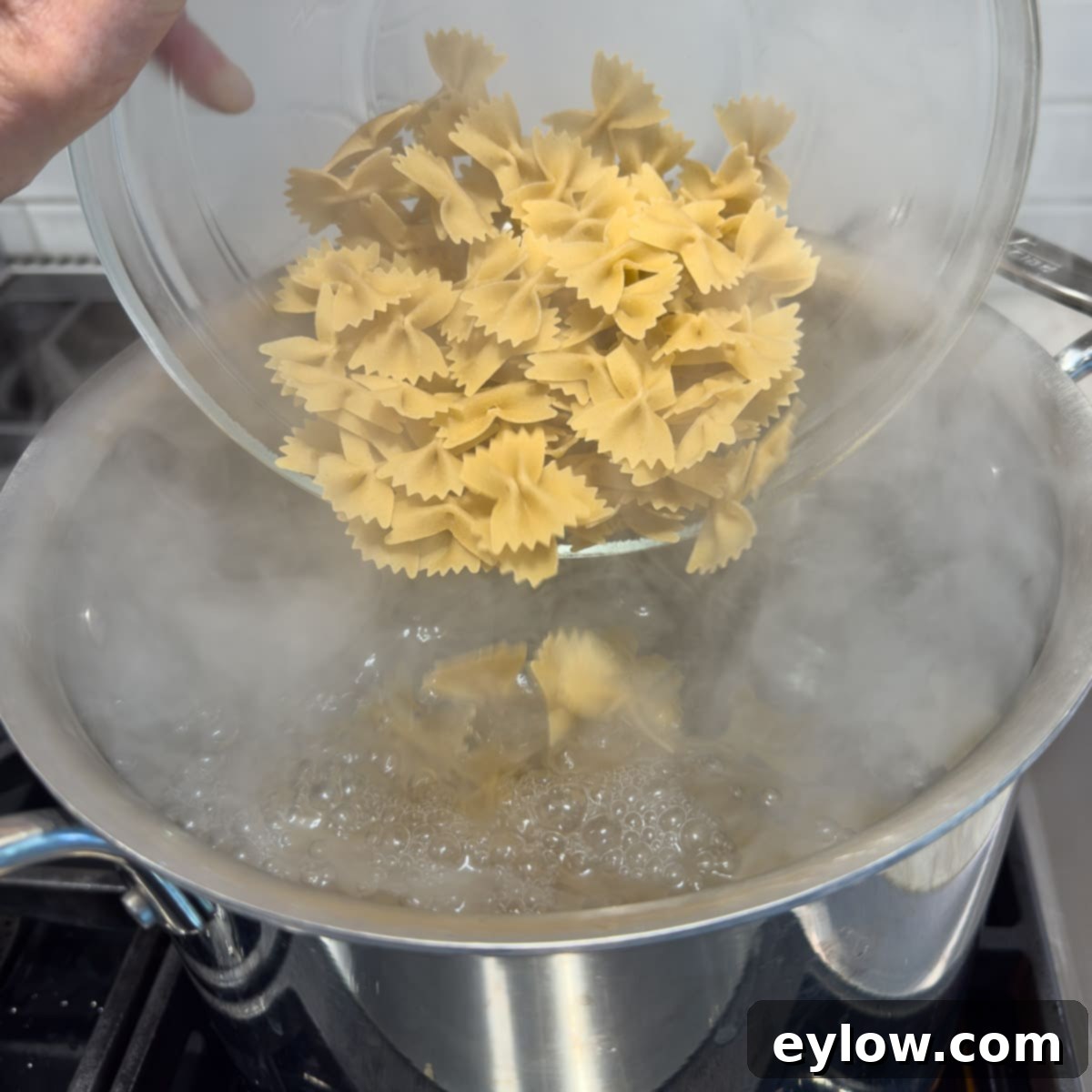
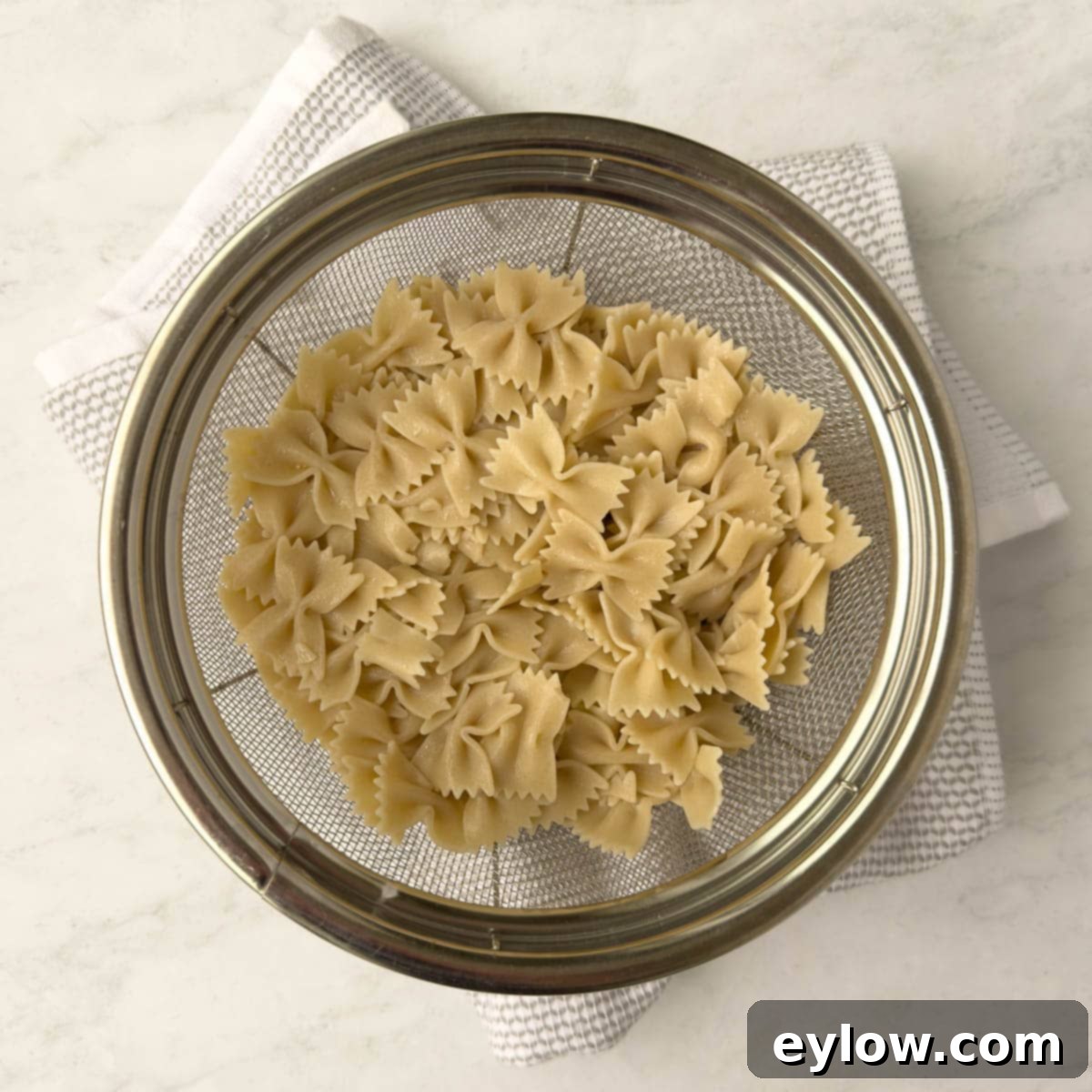
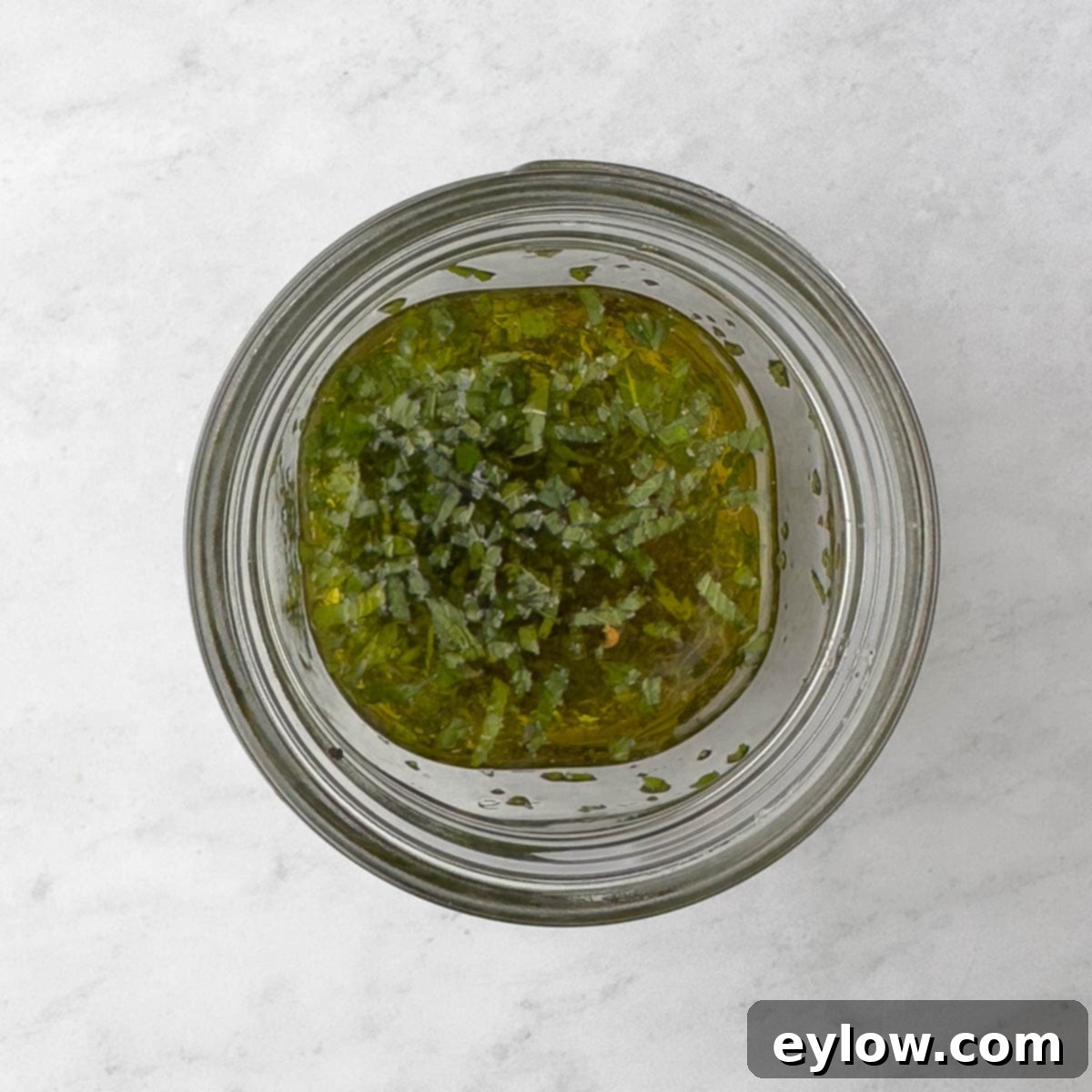


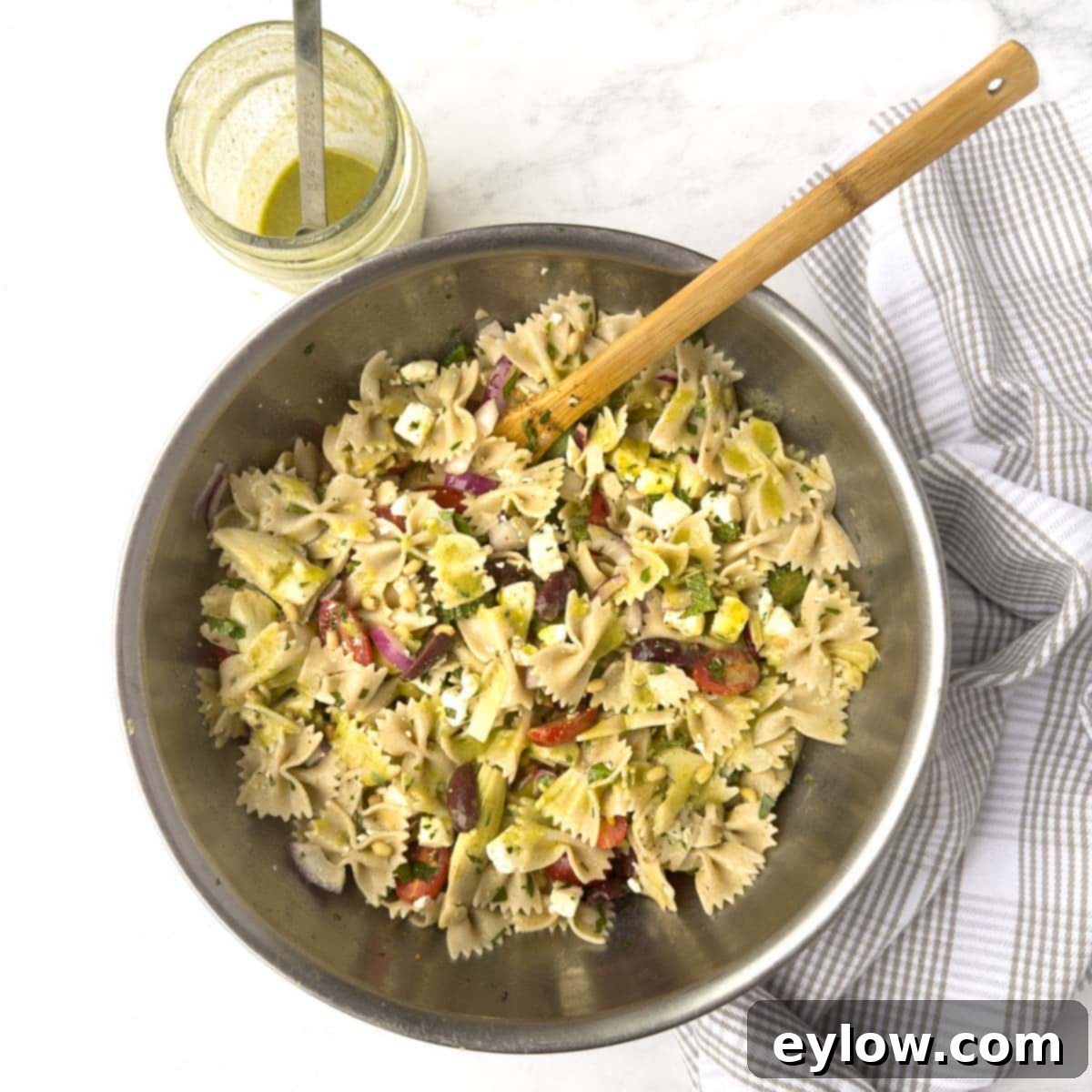
Delightful Serving Suggestions
This Mediterranean pasta salad is incredibly versatile and shines in many different contexts. While it’s absolutely fantastic on its own as a light meal, it truly excels as the perfect side dish for a variety of grilled proteins and summer favorites. Imagine it alongside succulent grilled chicken breasts, juicy shrimp skewers, classic beef burgers, or even this fantastic recipe for baby back ribs, perfectly started in the oven and finished on the grill. Its bright, refreshing flavors provide a beautiful contrast to richer main courses.
For an all-in-one main dish pasta salad, simply toss in some cooked, cubed chicken breast, or for a seafood twist, add a can of high-quality, low-mercury “safe catch” canned tuna. Serve this Mediterranean gem chilled or at room temperature; it’s delightful either way and always a welcome sight at any table. The best way to enjoy its full flavor profile is often at room temperature, as explained in our chef’s tip below.

Chef’s Tip: You’ll savor the flavors of Mediterranean pasta salad more at room temperature than straight from the refrigerator. This isn’t just a preference; it’s about how our tastebuds work. Cold foods tend to mute flavors, meaning they require more seasoning for us to truly taste them. Conversely, foods served at warm or room temperature allow flavors to bloom more fully with less seasoning. When serving, let your pasta salad sit out for 15-30 minutes after chilling to allow the ingredients to slightly warm up and for the dressing’s complexity to become more pronounced. Always taste and season appropriately just before serving.
Perfecting Your Picnic with Mediterranean Pasta Salad
Whether you’re planning a casual backyard picnic, an adventure in the park, or a sunny day at the beach, this tasty Mediterranean pasta salad recipe is your perfect companion. It’s robust, flavorful, and incredibly adaptable for outdoor enjoyment.
- Smart Packing Solutions: For family-style sharing, pack your Mediterranean pasta salad in one large, airtight container with a secure lid to prevent spills. Alternatively, for ultimate convenience, portion the salad into individual containers. These are not only easy to fit into a picnic basket but also allow each person to enjoy their own perfectly sized portion, minimizing mess.
- Always Pack Extra Vinaigrette: Pasta salads, especially those with pasta, tend to absorb dressing over time. To ensure your salad remains perfectly moist and flavorful throughout your picnic, pack a small, separate container of extra lemon-herb vinaigrette. This way, you can refresh the salad just before serving, or guests can add more to their individual portions.
- Keep Proteins Separate: If you’re adding grilled chicken, shrimp, or other proteins, it’s often best to pack them in a separate container. This keeps them at their optimal temperature and prevents them from soaking up too much dressing or altering the texture of the salad prematurely.
- Don’t Forget Cleanup Essentials: A successful picnic requires more than just delicious food. Remember to pack those handy cleanup towelettes or wet wipes, a generous stack of napkins, and dedicated trash bags to easily carry home any waste, leaving your picnic spot pristine.
- Easy Picnic Desserts: For a delightful sweet finish that travels well, consider these bite-sized chocolate bark bites. Or, for chocolate lovers, these decadent gluten-free bittersweet German chocolate brownies are a rich and satisfying treat that’s surprisingly easy to transport.
Common Questions About Mediterranean Pasta Salad
Here are answers to some frequently asked questions to help you master your Mediterranean pasta salad.
Rinsing pasta for a pasta salad under cold water serves two main purposes. Firstly, it immediately stops the cooking process, preventing the pasta from becoming mushy or overcooked, which is crucial for a firm al dente texture. Secondly, rinsing removes excess starch from the pasta’s surface. This starch can cause the pasta to become sticky and clump together as it cools, resulting in a dense, undesirable texture. By rinsing, you ensure the pasta remains loose, separate, and perfectly suited for a non-clumpy pasta salad. It’s important to note that this rinsing technique is specifically for cold pasta salads; for hot pasta dishes, you typically do not rinse the pasta to allow the starch to help the sauce cling.
To effectively cool pasta for pasta salad, begin by draining it immediately after cooking. Then, briefly rinse it under cold water in the colander. Give the colander a good shake to remove as much excess water as possible. For the quickest and most efficient cooling, transfer the rinsed pasta to a large, shallow casserole dish or spread it out on a large baking sheet. This maximizes the surface area exposed to the air, allowing the pasta to cool down much faster and preventing it from sticking together. Alternatively, if a shallow dish isn’t available, a large bowl will work, but ensure you toss the pasta periodically to prevent clumping as it cools.
When preparing pasta for a pasta salad, it is indeed beneficial to add a very small amount of olive oil after cooking and draining. This light coating of olive oil helps to prevent the pasta from sticking together as it cools, ensuring it remains loose and individual. However, be mindful not to use too much, as it could make the pasta overly oily. This technique differs from hot pasta dishes, where olive oil is often omitted after cooking because the sauce is designed to cling directly to the starchy pasta surface.
More Inspiring Summer Salad Recipes
For more refreshing and cool meal ideas to help you navigate the summer heat, explore our extensive salads recipe category. You simply can’t beat a light and satisfying entree salad like this incredible grilled shrimp salad with a vibrant raspberry vinaigrette on a hot day. These recipes are designed to keep you cool, healthy, and delighted throughout the season.
- Crunchy Broccoli Salad with Bacon
- Simple Easy Coleslaw Recipe
- Strawberry Goat Cheese Salad
⭐️Did You Make This Recipe? Share Your Experience!
If you tried your hand at making this delightful Mediterranean pasta salad, we would absolutely love to hear from you! Please take a moment to add your comment below. Your feedback is incredibly valuable, and we truly enjoy hearing about your culinary adventures. If you loved the recipe and it became a new favorite, please consider giving it a 5-star rating! Your ratings and reviews are a huge help to other readers searching for delicious, reliable recipes.
📖 Recipe

Mediterranean Pasta Salad
Sally Cameron
Pin Recipe
Equipment
-
Large pot to cook pasta
Ingredients
Lemony Vinaigrette (makes extra, 1 cup total)
- ¾ cup extra virgin olive oil
- ¼ cup + 2 tablespoons fresh lemon juice zest before juicing, use to garnish for extra zing
- 2 tablespoon fresh finely chopped thyme or oregano choose your favorite Mediterranean herb!
- 2 tablespoon fresh finely chopped mint adds a refreshing coolness
- 1 teaspoon smooth Dijon mustard for emulsification and depth of flavor
- 2 large garlic cloves finely zested or minced
- ¼ teaspoon sea salt or to taste
- ¼ teaspoon ground black pepper freshly ground is best
- 1 pinch red chili flakes for a subtle kick, optional
- ½ teaspoon honey optional, to balance tartness
Pasta Salad
- 8 ounces gluten-free pasta (or wheat) short pasta like elbows, bows (farfalle), mini penne, or rotelle
- 3 small Persian cucumbers seeded if necessary, quartered and diced for texture
- 18-20 small grape or cherry tomatoes halved, about 6 ounces for bursts of sweetness
- 6 ounces Greek feta cheese crumbled, for tangy, salty notes (omit for dairy-free)
- 20 pitted Greek Kalamata olives halved or left whole for a briny, savory kick
- 1 15-ounce can artichoke hearts packed in water rinsed, thoroughly drained, and halved if large
- 1 tablespoon fresh chopped parsley for fresh garden flavor and color
- ¼ cup pine nuts toasted for best flavor and crunch, optional
- ¼ small red onion finely chopped, or use a milder shallot
Instructions
Make the dressing
-
To create a beautifully emulsified and slightly creamy vinaigrette, combine all the lemony vinaigrette ingredients in a blender and process until smooth. This technique helps to combine the oil and lemon juice perfectly. Alternatively, you can whisk all the ingredients vigorously in a bowl, ensuring your fresh herbs and garlic are very finely chopped. Another simple method is to place all ingredients in a jar with a tight-fitting lid and shake it very well until combined. Taste the dressing and, if you find it too tart for your preference, add a small amount of honey to balance the flavors. Once prepared, set the dressing aside, ready to coat your pasta salad.
Cook pasta
-
Bring a large pot of generously salted water to a rolling boil. Add your chosen pasta and cook it according to the package directions, being careful not to overcook. For the best pasta salad texture, aim for an “al dente” consistency, where the pasta is tender yet still firm to the bite. Begin checking the pasta about 1 minute before the minimum cooking time indicated on the package. As soon as it reaches al dente, drain the pasta immediately in a colander. Briefly rinse it under cold water to stop the cooking process and wash away excess starch, which helps prevent clumping. Shake the colander well to remove as much water as possible, then toss the cooled pasta with a very small amount of olive oil to keep the strands separate. Allow the pasta to cool completely to room temperature before assembling the salad.
Make the pasta salad
-
Once the pasta has fully cooled, transfer it to a large mixing bowl. Add in the diced cucumbers, halved tomatoes, crumbled feta cheese, pitted Kalamata olives, drained and chopped artichoke hearts, and the pine nuts. Drizzle about 2-3 tablespoons of your prepared lemon-herb vinaigrette over the ingredients. Using large serving spoons or tongs, gently toss the entire mixture until all the vegetables, cheese, nuts, and pasta are well combined and lightly coated with the dressing. Avoid over-mixing to prevent breaking the pasta or bruising the vegetables. Taste the salad and add more dressing as needed, depending on your preference for moisture and flavor intensity. Chill the prepared Mediterranean pasta salad until you are ready to serve.
Garnish
-
For a final touch of freshness and visual appeal just before serving, sprinkle the pasta salad with a little more freshly chopped herbs. Extra chopped mint is particularly lovely, adding an invigorating aroma. You can also add more pine nuts if desired for an enhanced crunch. Don’t forget to use the reserved lemon zest from when you prepared the dressing; sprinkling it over the top adds beautiful color and an extra burst of bright lemony flavor.
To Make ahead
-
This Mediterranean pasta salad is an excellent make-ahead dish, perfect for simplifying party prep. Cook the pasta as directed, toss it with a little olive oil after rinsing, and let it cool completely before refrigerating. Perform all the other prep work: make the dressing, slice your vegetables, and crumble the cheese. Keep all these components stored separately in airtight containers in the refrigerator. This approach ensures the freshest possible salad. When you’re ready to serve, simply combine all the prepped ingredients with the cooled pasta and toss with the dressing. Always serve with extra dressing on the side, as pasta can absorb liquid over time.
Notes
To tame the sharp bite of red onion for a pasta salad, finely chop or slice the onion, then rinse it thoroughly under cold water and pat it completely dry. This simple trick significantly mellows its raw intensity, making it more palatable in the salad. Alternatively, use a milder shallot.
